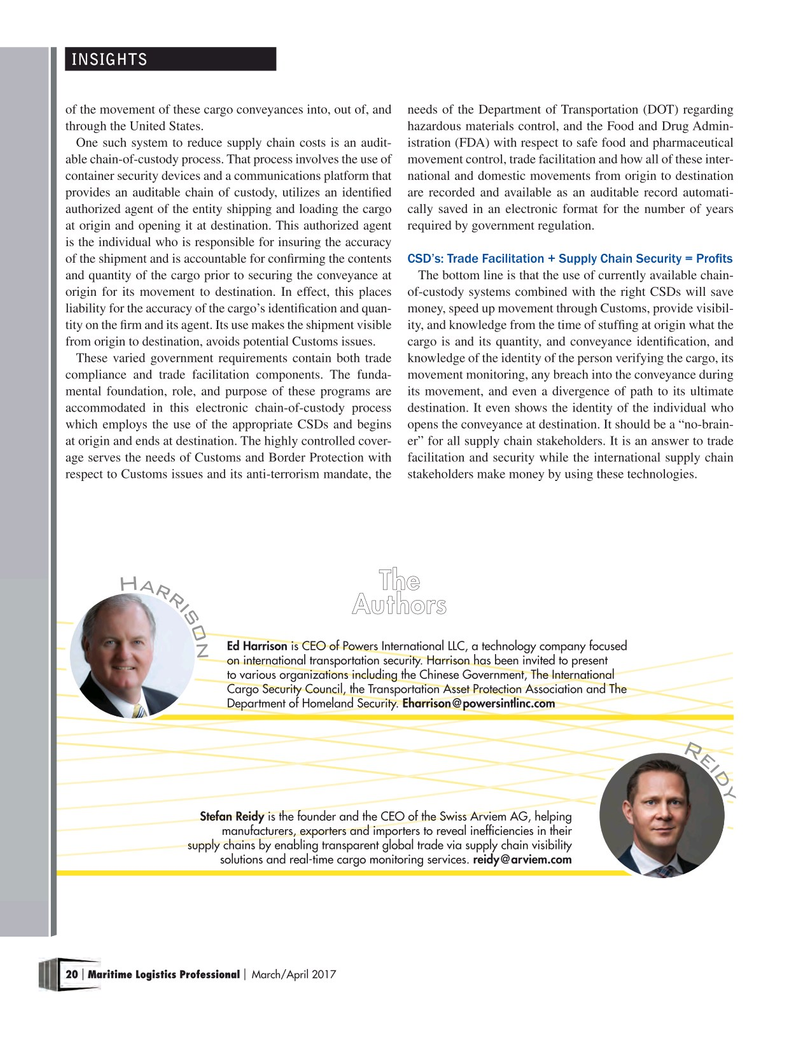
Page 20: of Maritime Logistics Professional Magazine (Mar/Apr 2017)
IT & SOFTWARE
Read this page in Pdf, Flash or Html5 edition of Mar/Apr 2017 Maritime Logistics Professional Magazine
INSIGHTS of the movement of these cargo conveyances into, out of, and needs of the Department of Transportation (DOT) regarding through the United States. hazardous materials control, and the Food and Drug Admin-
One such system to reduce supply chain costs is an audit- istration (FDA) with respect to safe food and pharmaceutical able chain-of-custody process. That process involves the use of movement control, trade facilitation and how all of these inter- container security devices and a communications platform that national and domestic movements from origin to destination provides an auditable chain of custody, utilizes an identi? ed are recorded and available as an auditable record automati- authorized agent of the entity shipping and loading the cargo cally saved in an electronic format for the number of years at origin and opening it at destination. This authorized agent required by government regulation. is the individual who is responsible for insuring the accuracy of the shipment and is accountable for con? rming the contents CSD’s: Trade Facilitation + Supply Chain Security = Pro? ts and quantity of the cargo prior to securing the conveyance at The bottom line is that the use of currently available chain- origin for its movement to destination. In effect, this places of-custody systems combined with the right CSDs will save liability for the accuracy of the cargo’s identi? cation and quan- money, speed up movement through Customs, provide visibil- tity on the ? rm and its agent. Its use makes the shipment visible ity, and knowledge from the time of stuf? ng at origin what the from origin to destination, avoids potential Customs issues. cargo is and its quantity, and conveyance identi? cation, and
These varied government requirements contain both trade knowledge of the identity of the person verifying the cargo, its compliance and trade facilitation components. The funda- movement monitoring, any breach into the conveyance during mental foundation, role, and purpose of these programs are its movement, and even a divergence of path to its ultimate accommodated in this electronic chain-of-custody process destination. It even shows the identity of the individual who which employs the use of the appropriate CSDs and begins opens the conveyance at destination. It should be a “no-brain- at origin and ends at destination. The highly controlled cover- er” for all supply chain stakeholders. It is an answer to trade age serves the needs of Customs and Border Protection with facilitation and security while the international supply chain respect to Customs issues and its anti-terrorism mandate, the stakeholders make money by using these technologies.
The a
H r r i s
Authors o n
Ed Harrison is CEO of Powers International LLC, a technology company focused on international transportation security. Harrison has been invited to present to various organizations including the Chinese Government, The International
Cargo Security Council, the Transportation Asset Protection Association and The
Department of Homeland Security. [email protected]
R e i d y
Stefan Reidy is the founder and the CEO of the Swiss Arviem AG, helping manufacturers, exporters and importers to reveal inef? ciencies in their supply chains by enabling transparent global trade via supply chain visibility solutions and real-time cargo monitoring services. [email protected] 20 Maritime Logistics Professional March/April 2017 | |

 19
19

 21
21
